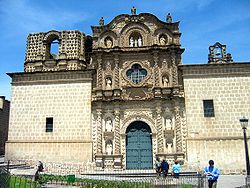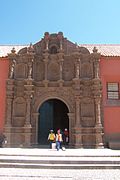This article needs additional citations for verification .(August 2012) |

Andean Baroque (Spanish: Barroco andino or arquitectura mestiza) is an artistic movement that appeared in colonial Peru between 1680 and 1780. [1] It is located geographically between Arequipa and Lake Titicaca in what is now Peru, where rules over the highlands and spreads over the entire altiplano. From the Portuguese word barrueco meaning impure, mottled, flamboyant, daring, the most striking example of Andean Baroque art is in religious architecture, where criollo and indigenous craftsmen together gave it a unique character, as happened in the New Spanish Baroque.





